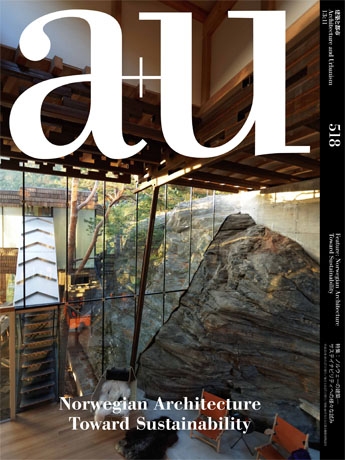#0165 Norwegian Sustainability A+U
Publication
A + U Japan
Date
#518, 2013
Author
Co-authorship Mirza Mujezinovic and Halvor Weider Ellefsen
Publication
A + U Japan
Date
#518, 2013
Author
Co-authorship Mirza Mujezinovic and Halvor Weider Ellefsen
Download PDF
The Possibility of tradition
An early advocate for environmental awareness and ecological thinking in Norwegian architecture was Knut Knutsen, that through his essay “Mennesket i Sentrum”, published in architectural magazine “Byggekunst” in 1961, provided a humanist, ecological manifesto for a modest and restrained architecture in a world of limited resources, contrary to the imaginaries of heroic utopia projected by his Norwegian colleagues and by the international architecture culture of the 1960s. The connotations from Knutsen’s professional approach to context to current sustainability debates are obvious. Through the 50s and 60s, forms of environmental awareness manifested themselves both through the built environment and through architectural theory. Practicing architects like Wenche Selmer and Eliassen & Lambert-Nielsen evolved the legacy of Knutsen, stressing the importance of context and material use, while theorist Christian Norberg-Schulz addressed the issues of “place”, monumentality and tradition for over a decade as the editor of “Byggekunst”. Common to the above mentioned is that their environmental awareness was a disciplinary instrument as much as a political statement: What we today call “Sustainability” was an integrated aspect of architectural production, as well as a tool to articulate regional specificity and tradition in an increasingly globalized modernity.
The Possibility of tradition
An early advocate for environmental awareness and ecological thinking in Norwegian architecture was Knut Knutsen, that through his essay “Mennesket i Sentrum”, published in architectural magazine “Byggekunst” in 1961, provided a humanist, ecological manifesto for a modest and restrained architecture in a world of limited resources, contrary to the imaginaries of heroic utopia projected by his Norwegian colleagues and by the international architecture culture of the 1960s. The connotations from Knutsen’s professional approach to context to current sustainability debates are obvious. Through the 50s and 60s, forms of environmental awareness manifested themselves both through the built environment and through architectural theory. Practicing architects like Wenche Selmer and Eliassen & Lambert-Nielsen evolved the legacy of Knutsen, stressing the importance of context and material use, while theorist Christian Norberg-Schulz addressed the issues of “place”, monumentality and tradition for over a decade as the editor of “Byggekunst”. Common to the above mentioned is that their environmental awareness was a disciplinary instrument as much as a political statement: What we today call “Sustainability” was an integrated aspect of architectural production, as well as a tool to articulate regional specificity and tradition in an increasingly globalized modernity.
